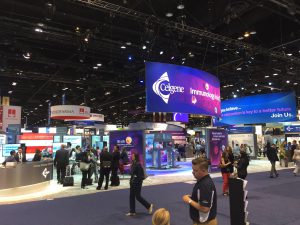The posters in the clinic at Gibbs Cancer Center, a regional hospital in Spartanburg, South Carolina, say “Help Stop Cancer.” Volunteers who agree to donate blood will receive a $25 gift card and their donation will help “determine if a new blood test can be used to detect cancer earlier.”
The posters are paid for by Grail Inc., a Silicon Valley startup that last year began laying out a bet that the “cure” for most cancers isn’t a new drug, but tests that catch tumors at an early stage when they can still be successfully treated. Grail thinks it can do that using “high-intensity” DNA sequencing to probe blood samples for genetic material shed by hidden tumors.
Grail has raised $1.1 billion, a sum that puts it among the top three most heavily funded private biotech companies, according to EvaluatePharma. The company will need that money and more to win a technological race that is as significant, and as costly, as those toward driverless vehicles or new forms of artificial intelligence. Investors include gene-sequencing giant Illumina, Johnson & Johnson, and Amazon founder Jeff Bezos.
Huge and expensive studies will be needed to discover the fingerprints of cancer and then prove a “screening” test really helps. Grail last year began seeking blood from 7,000 cancer patients at Gibbs and other community hospitals, and in April began exploring whether it can improve on mammograms, an x-ray of the breast that women are advised to get annually starting at age 45, by finding breast cancers earlier, and finding more of them.
To do so, Grail is now seeking 120,000 women to provide blood when they undergo mammograms at centers including the Mayo Clinic. About 650 of those women, cancer statistics forecast, will go on to develop breast cancer within a year of entering the study. Grail will then analyze their banked blood to determine whether a DNA test could have correctly “predicted” their cancer from a blood draw.
Source: MIT Technology Review


 Thought this was worth sharing from MIT Technology Review. After attending ASCO last week what I thought might happen a year or two again actually has. Pathologists no longer have to worry about stepping out from behind the paraffin curtain as many of us were fond of saying. Tissue is not the issue anymore. At least not formalin fixed, paraffin embedded (FFPE) tissue. Liquid tissue is now gold. Or platinum. Cancer diagnostic and treatment is big business. At one point these clinical trials and drug discovery pipelines required FFPE and a pathologist to recognize the morphology. Certainly we still will require tissue biopsies to render the diagnosis to guide best clinical practices for therapy but as I mentioned
Thought this was worth sharing from MIT Technology Review. After attending ASCO last week what I thought might happen a year or two again actually has. Pathologists no longer have to worry about stepping out from behind the paraffin curtain as many of us were fond of saying. Tissue is not the issue anymore. At least not formalin fixed, paraffin embedded (FFPE) tissue. Liquid tissue is now gold. Or platinum. Cancer diagnostic and treatment is big business. At one point these clinical trials and drug discovery pipelines required FFPE and a pathologist to recognize the morphology. Certainly we still will require tissue biopsies to render the diagnosis to guide best clinical practices for therapy but as I mentioned 






























Liquid biopsies and other somatic DNA mutation approaches claim to, one day, replace pathology but this argument is flawed. Current studies start with two groups: patients with cancer and healthy controls. The cancer in the first group was diagnosed by pathologists who remain the gold standard. Where are the studies showing liquid biopsy data from all patients at presentation, prior to radiology and biopsy?